The context of the Saab 32 history
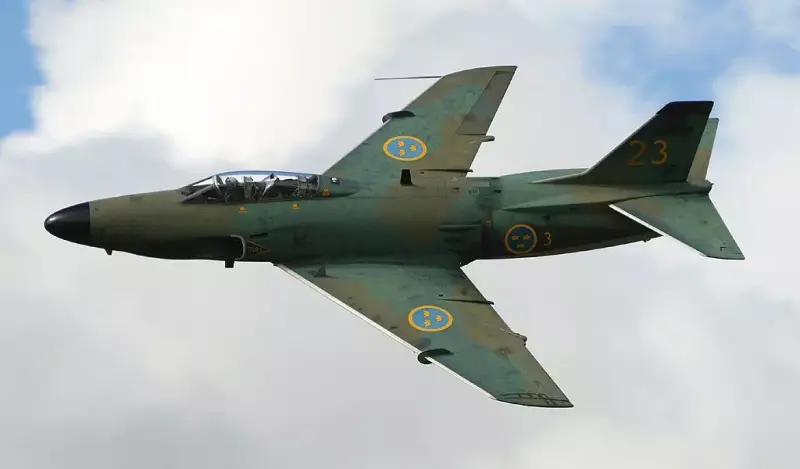
At the dawn of the jet era, aircraft were similar. And even despite the fact that I don’t really like theses a la “all planes are the same”, in this context I am ready to accept it. After all, the approach to new technology in most countries could not be strikingly different.
It is clear that each aircraft has some distinctive features by which it could be identified, but the difference between, for example, the MiG-15, La-15 and F-86 or the Yak-15 and Saab 29 Tunnan is very small. Nevertheless, they are different, at least in terms of tactical and technical data, knowing which it is virtually impossible to confuse them.
And in this regard, there is one jet aircraft with excellent performance, new design and history, which elevated its creators to the level of leading manufacturers aviation in the world. In general, these criteria can describe many different aircraft, but we will concentrate our attention on one particular little-known aircraft.
So, in this article, we will dive into the context of the Saab 32 Lansen fighter, based on the history of the company, industry innovation and, to a lesser extent, the history of the Swedish Air Force.
By the phrase "let's start from afar" I mean - the search for starting points. Of those that I found important, we will highlight three, talking about them in a list, while leaving room for interweaving between each of them.
Let's start with a story about the SAAB concern, as the most important part of the Saab 32 history.
Concern SAAB
Few people know, but the history of one of the most famous car manufacturers, Saab, began with the defense industry. Just like aviation. It all turned out like this.
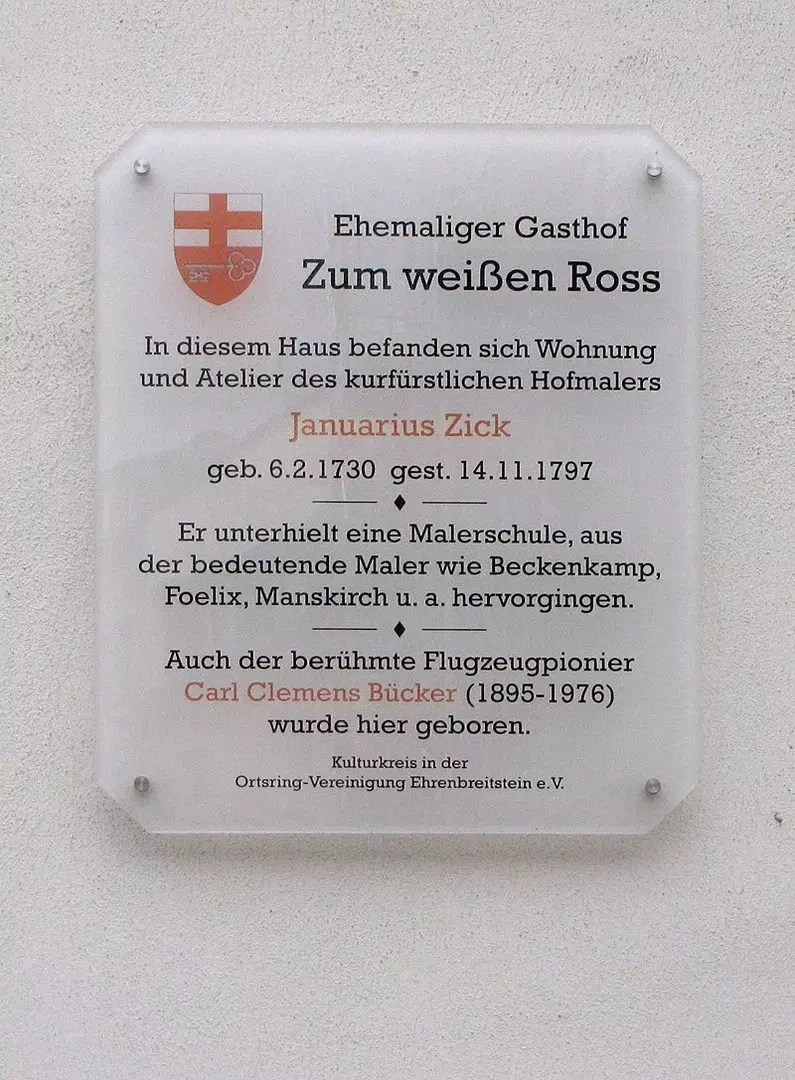
Memorial plaque dedicated to Karl Buecker
In 1921, the German pilot Karl Buecker decided to buy a reconnaissance aircraft, most likely it was Caspar U.1, from the Caspar-Werke company from the Weimar Republic with the aim of their subsequent assembly in Sweden, which had recently joined the League of Nations, and thereby bypassing the conditions of peaceful Treaty of Versailles.
However, it would be foolish not to pay attention to various indulgences in this set of rules created for Germany. For example, in its first version, the production of aircraft in Germany was prohibited, and airlines were forbidden to operate multi-engine aircraft.
For a humiliated and defeated Germany, this was fraught with two consequences: the first was a gigantic blow to industry and the economy, which could not be dealt with without third-party injections or violation of the treaty; the second is the outflow of aircraft manufacturing companies abroad, where there were no such restrictions. That is, not only did the Germans have to give up part of their vital territories and pay astronomical reparations under this agreement, but also the industrial base, with which it was possible to remain a functioning country, was destroyed.
In any case, in order to continue to receive reparations and not go to the Ruhr area, concessions were needed, which came into force as early as 1921. Now the production of civilian aircraft was allowed, albeit with scheduled inspections, with the approval of international commissions, while the military was still banned.
In 1926, one gigantic unified civil airline will be created - Lufthansa. Erhard Milch, later one of the creators of the Luftwaffe along with the more famous Hermann Goering, will be its manager and later commercial director. An important component for the strongest Air Force in Europe in Germany will be just the management of Milch, who skillfully created the Junkers Ju 52 civilian aircraft, which would later become one of Adolf Hitler's many personal aircraft.
With this project, Erhard killed two birds with one stone: and gave experience to his pilots, who in the future will be used for a humiliating war; and developed the military industry (a total of 4 such aircraft will be built). But not only due to this, the Luftwaffe was so strong and numerous in the period of the 845-1930s, although this story can be cited as an illustrative example.
And since we're talking about it. To understand the actions of Hitler, there are a huge number of prisms with which to look at them. But here I try to do it using examples from aviation, as well as through the lens of the industry as a whole. So, it turns out that one of the problems, without the solution of which the military machine of the Third Reich would not start, was the outflow of aviation. Take, for example, Heinkel, about which the story will be a little later, but we point out that he will transfer part of his small production to Sweden.
Without such a company and the skills of the people involved in it, it would be foolish to start a war, so they had to be returned to permanent work. But for this they needed military contracts, and for military contracts the Treaty of Versailles was categorically not needed. As a result, Adolf Hitler, who came to power in January 1933, decides to ignore this document, thereby giving carte blanche to create his large army. And already in June, Heinkel will begin the creation of its main brainchild - the He 111 bomber.
The signal for the start of development, by the way, was a visit to the company by a certain Albert Kesselring, who, just in 1933, would be transferred to the Reich Commissariat for Aviation. However, this is just one of the ideas on how you can try to understand the politics of the Third Reich, and other countries too. You can look at the history of any country through the prism of resources, technology, ideology, economy, but I'm interested in aviation.
But back to Buker.
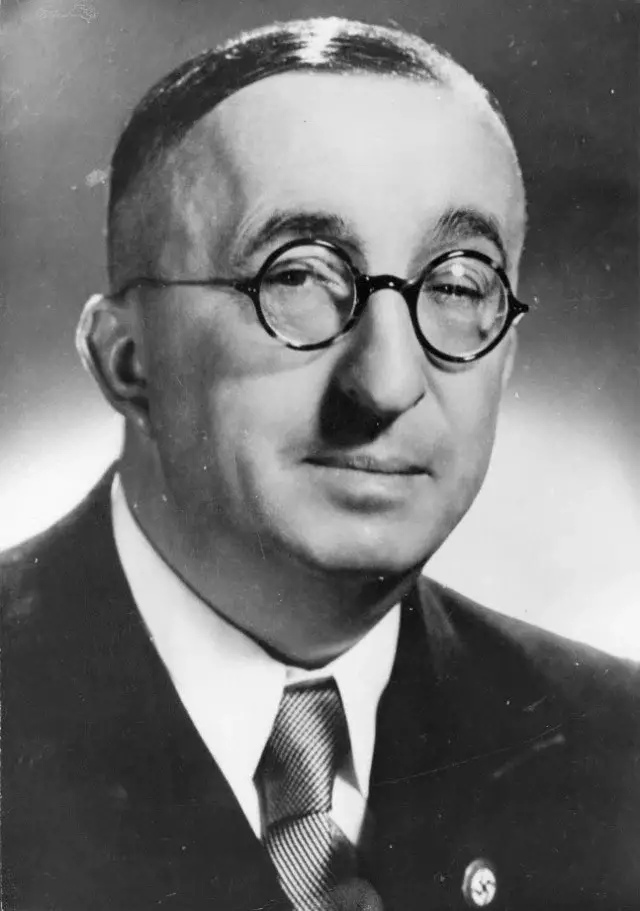
Ernst Heinkel
Even before the easing, when companies were looking for workarounds, he managed to negotiate with a certain Ernst Heinkel, whose name the aircraft company he founded would be named after a year later, although so far he was the chief designer at Casper-Werke. Now the previously mentioned company could start building its aircraft in Sweden.
In order to manage this process and not sleep in front of the incredibly sharp-eyed observers from the former Entente, Heinkel and Bücker on September 10, 1921 in the city of Lidingo create a new company - Svenska Aero. Now, legally, the contract for the production of the aircraft and future aircraft was at the disposal of Sweden, but a considerable part of the German developers, after signing the contract, went along the same route as the contract itself. Buecker himself became CEO and sole board member of the new company.
However, such a special operation could not remain without cover. It was very extensive, after all, if the League of Nations noticed strange activity between German companies and Sweden, both could get it.
As a result, for Svenska Aero in 1922–1923. a large shipyard will be vacated, in the municipality of Skarstara in Lidingo. Now the company could accept contracts from the Swedish state. It was also decided that most of the production continued to remain in more experienced shipyards in Germany, although legally the production was Swedish, so the commissions had nothing to complain about. Especially when the production of the German part of the aircraft was scattered throughout the country, which could cause even more problems for the commission.
Moreover, the last part of production ended not in the hands of Svenska Aero or Casper-Werke, but TDS (Torpeddepartementet på flottans varv i Stockholm - “torpedo department at the naval pier in Stockholm”), which turned the process of creating aircraft into a real Bermuda Triangle.
But this part of the history of the future SAAB concern would not make sense if it were not for the move to the shipyard in Lidingo. Indeed, already in 1922, Heinkel would go to the company he created, and in 1928 Casper-Werke would be disbanded, and without them the Swedish company would not have been able to fulfill the contracts that were to be realized.
But orders began to come already from the Swedish government, and in the mid-1920s there was already a body created for the production of our own aircraft within Svenska Aero itself. In 1930, Sven Blomberg, formerly of Heinkel, and Anders Johan Andersson from Messerschmitt will join the design department. A good base for our own production of high-quality aircraft.
But the state already had its own companies to which they gave contracts, while Burker's company was used for the production of prototypes. This will entail financial problems and the imminent sale of the company AB Svenska Järnvägsverkstädernas Aeroplanavdelning (ASJA), established in September 1930, a branch of the railway production of the leader company in Linköping, AB Svenska Järnvägsverkstädernas, trying to diversify production into new industries. One of them was aviation.
Now let's talk about them separately.
AFF
As I said, this company was an offshoot of a railroad company that had made good progress within its industry. But soon their business began to decline, and the search for a new industry for production began. Among them were heating boilers and heat exchangers, created under the Parca brand. But one of the most productive industries has become aviation.
It all started with a small number of personnel - by 1933 there were only 100 employees. At the same time, ¼ of them were carpenters, as the tree continued to be an important component for the creation of the aircraft. Like Svenska Aero, it all started with the licensed production of foreign aircraft, and domestic ones too, including the J6 Jaktfalken fighters, which were created by Svenska Aero.
Let them start developing their own machines after that. One of the first successful was the four-seat high-wing piston ASJA Viking II, a continuation of the ideas of the ASJA L1 Viking, which was a seaplane and did not go into mass production. At the same time, albeit limited, but communication was established with other aviation companies in Sweden.
In 1936, the company was awarded a very large contract by the Riksdag, the Swedish legislature. According to their calculations, until 1943, inclusive, Flygvapnet (the so-called Swedish Air Force) should be purchased 257 combat and 80 training aircraft. To accomplish this task, ASJA teamed up with Bofors, a Swedish manufacturer weapons, as a result of which, on March 31, 1937, the prototype of the future SAAB was created - AB Förenade Flygverkstäder (AFF).
But this company did not last long. ASJA wanted to propose a project for a new army and patrol aircraft based on the ASJA L10 (future SAAB 17), but not through AFF, but completely independently. That is, both production and profits were in favor of ASJA. Many of the AFFs turned out to be dissatisfied with this fact, because if one of the participants performs such actions, then what is the essence of such cooperation. "Reasonable" - they thought in ASJA, and in the spring of 1939 the association was liquidated.
Now a very long project of treaties and compromises has begun, leading the two recent allies down two different paths to two different outcomes. Bofors are now part of BAE Systems (a British company) and ASJA have become the main part of Sweden's largest new aircraft manufacturer, Svenska Aeroplan AB or simply SAAB.
Already by the name you could guess that the second part was our old friends, sold in favor of ASJA back in 1932 for 25 kroons - Svenska Aero. By the way, Anders Johan Andersson also came with them. Or rather, he returned, because with the sale of the company, he went back to Germany with Karl Buecker. Together they founded the fairly well-known aircraft manufacturer Bücker-Flugzeugbau GmbH, which created the Bücker Bü 000 and Bücker Bü 181 trainers.
After the outbreak of World War II, Andersson returned to Sweden, to the newly created SAAB company, where he contributed to the creation of the Saab 18 bomber, to which let's move on, because it became another reference point for the Saab 32.
Saab 18
Let's try to run through the plane briefly, yet the article should be about the Saab 32, and here we are ranting.
Initially, that is, before the Second World War, the Swedish Air Force did not want gigantic production volumes, but they wanted the simple fulfillment of contracts, without which, of course, the existence of Sweden was called into question. Back in 1934, the development of a bomber began in Germany, created by the Junkers and Heinkel companies, from the struggle of which the Junkers Ju 86 and Heinkel He 111 were obtained, which could also work as civilian vehicles for Lufthansa. Wolves in sheep's clothing, so to speak.
It is interesting to know such historical facts, comparing them with others. For example, the fact that there was still a whole year before the creation of the Luftwaffe, which, however, did not prevent Goering and Milch from starting to build up weapons. Yes, and SAAB, actively cooperating with Germany, did not notice anything. Even opposite. Already in 1936, the Swedish Air Force will begin to purchase new Ju 86Ks, without asking why Hitler demanded the creation of bombers, bypassing the Treaty of Versailles.
Now we understand, because the Swedes were the exporter of iron ore for the Third Reich throughout the war, and volunteer armies, such as the Swedish Volunteer Corps and the Swedish Volunteer Company, actively fought against the USSR, first during the Winter War, and then during during the Great Patriotic War (I think it is not necessary to say that such ideologies are not born in a year or two, and not from one-time events).
But back to our story.
In total, the Swedish Air Force had 87 Junkers Ju 86 bombers. They were quite new and technologically advanced, and world events had not yet happened, and puny requirements and deadlines could be provided for the tender. As a result, the Swedish Air Force demanded a three-seat fast reconnaissance aircraft, which ASJA and the company AB Götaverken, so far unfamiliar to us, took up. The project of the second prevailed, but the economic overhead in the company and the departure of the chief designer led to the victory of the new SAAB company.
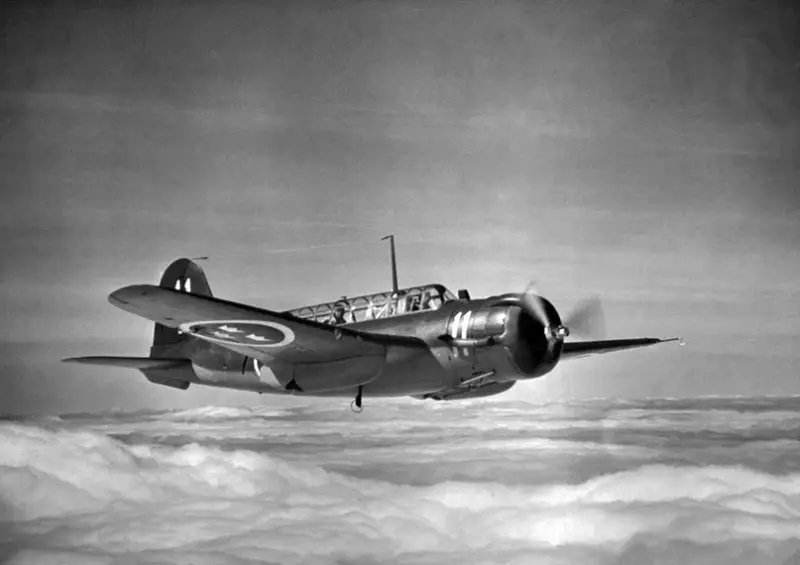
Saab 17
But soon the Second World War began, which could affect Sweden, and thoroughly. Now, the previous SAAB project, the ASJA L10, already named the Saab 17, which has become a dive bomber, has received more stringent deadlines. And despite the postponement of the first flight, the Saab 18 now had new requirements as a medium bomber that replaced the Ju 86K in the industry.
Prior to this, the idea of replacing German aircraft with domestic ones was definitely in the air in the future, but the Second World War quickly suggested that now this could not end with simple plans. The prototype of the updated Saab 18 made its first flight on June 19, 1942, together with the pilot, navigator and scorer. The overall speed for the class was not bad - 575-590 km / h, and the carrying capacity was on the level - a total of 1 kilograms. But it will be nothing compared to the speed and payload of the future Saab 800.
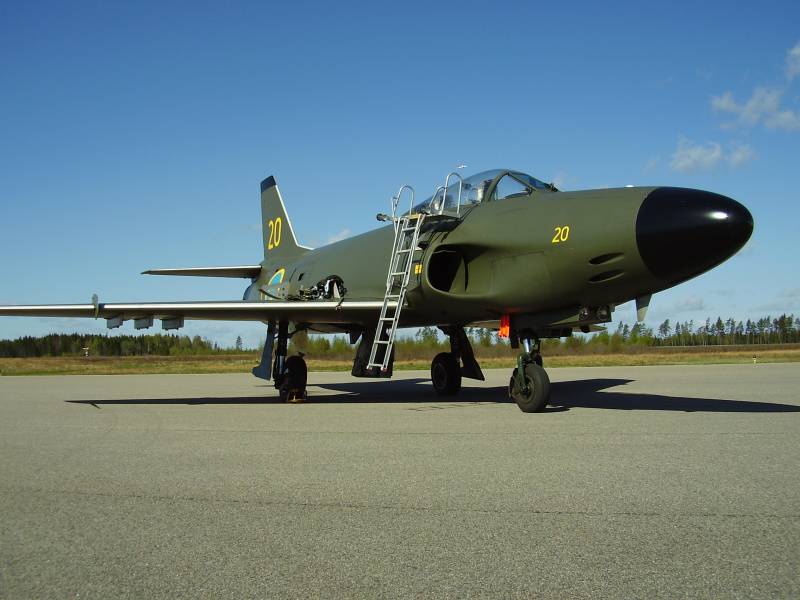
By the way, about this.
Let's now leave the history of the Swedish aircraft industry and move on to the third final premise. All three will later be useful to us at least for understanding the history of Saab 32. Or we just had a good time here for this kind of reflection. In any case, let's move on to the extreme topic at this stage - innovations in aviation.
Innovations in aviation
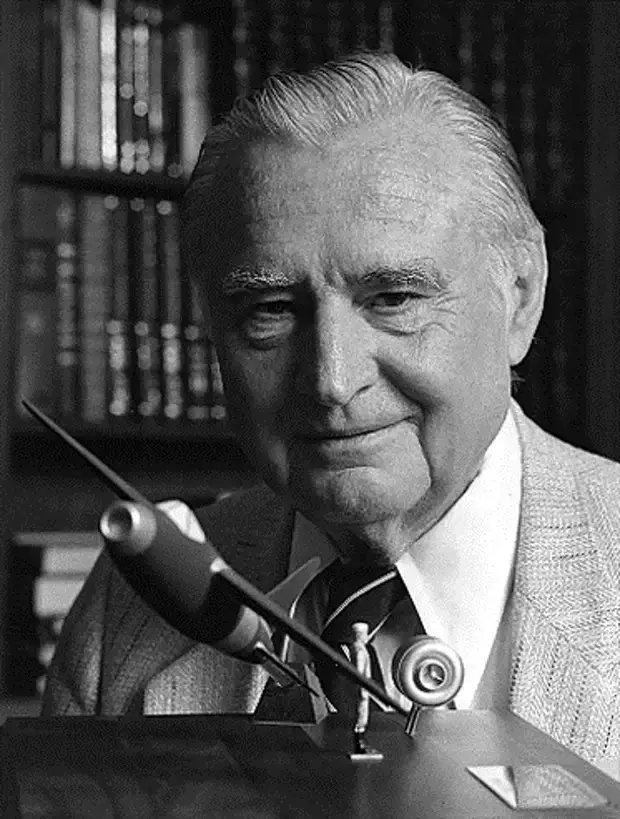
Hans von Ohain
In general, the history of the first jet engines began long before the Second World War. The fathers of turbojet engines, which are important for our particular history, are considered to be two people - Hans von Ohain (there is also a spelling Hans) and Frank Whittle. Both at the same time in the 1930s. developed the concept of using turbojet engines. They consisted of an air intake, a compressor, a combustion chamber, a turbine and an injector. At its core, it was an ordinary jet engine with all the attributes of the latter. Except, probably, bypass and afterburner, which will be created later and with the corresponding development.
Otherwise, everything worked the same way as on modern fighters - in a simple way: cold air is sucked in through the air intakes, compressed by compressors, mixed with fuel in the combustion chamber and thrown back, creating engine thrust and pushing multi-ton pieces of iron with wings and mechanization forward. This is told very, very simply and only to convey the essence, while not touching on turbofan engines, which deserve a separate story about them.
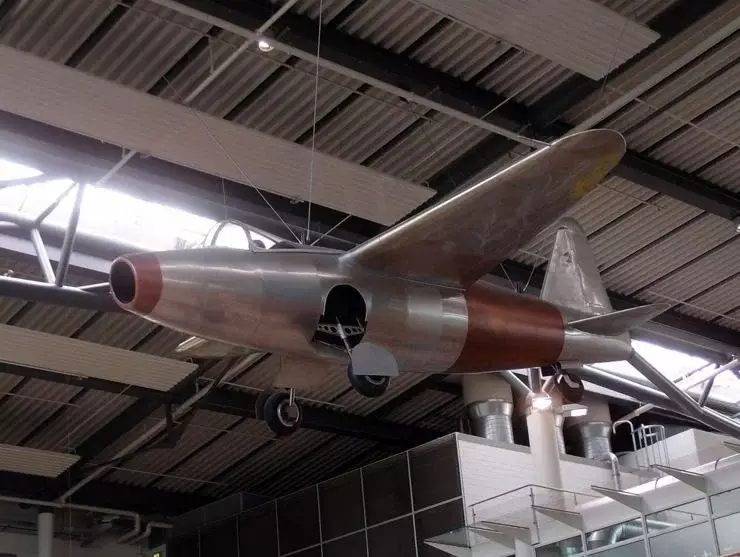
Heinkel He 178
The very first jet aircraft was the project of the restless and already mentioned Heinkel - Heinkel He 178, which took off on August 27, 1939. Of course, it was created under the leadership of Hans von Ohain, who was ahead of his British opponent in these endeavors. At the same time, Frank Whittle had previously begun campaigning for the creation of jet aircraft, back in the 1930s, but the most he could achieve was the ground tests of the brainchild of his company Power Jets Ltd in 1937.
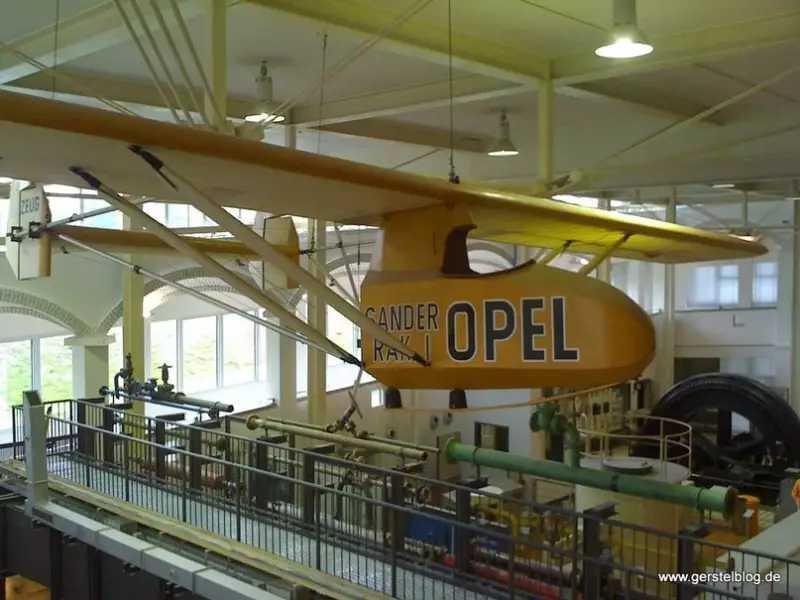
Opel RAK.1
Before them, because there is always something before, there were rocket planes, on which prototypes of jet engines were installed later. That is, the design of such aircraft was not initially adapted for the installation of rocket engines. The German glider Ente (“Duck”), which took off in 1928, was the absolute first such machine. In 1929, the result of the design reality of Julius Hatri and Fritz von Opel, the Opel RAK.1, the first special rocket aircraft, went on its first flight, although it still does not work to call its design adapted for flights using a rocket engine - there have not yet been proper studies. But it was the Heinkel He 178 that became the first jet non-rocket aircraft.
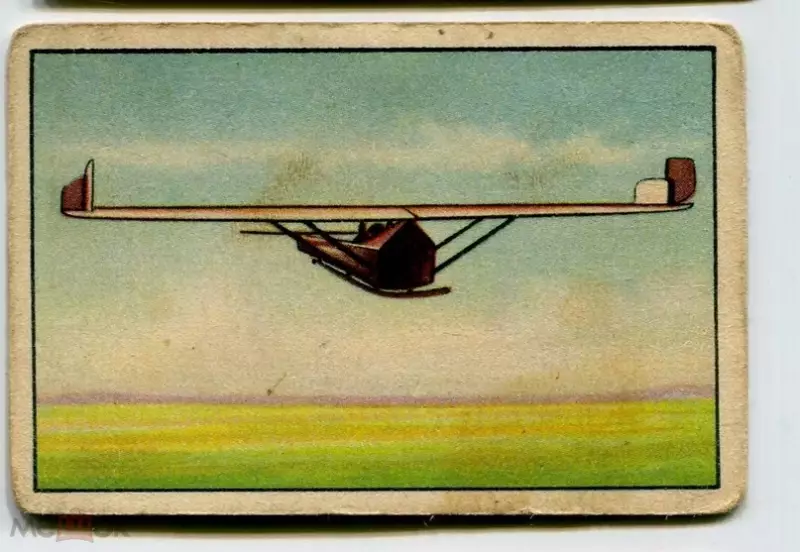
Small image supposed to be with Ente glider
The first combat fully jet aircraft was the famous Messerschmitt Me 262, which everyone has certainly heard of. But anyway, let's focus on it.
Messerschmitt Me 262
The development of this fighter began a few years before the Second World War, of course, under the leadership of Hans von Ohain.
There were not too many other aircraft designers who were so interested in the topic of jet fighters living in Germany and who could be given a contract to build this aircraft. Successful tests of the Heinkel He 178 and the invasion of Poland by the Third Reich, the universally recognized start of the Second World War, spurred the development of a new promising fighter, for which the power plant, no doubt, was to be a jet engine.
The chief designer of the project was Voldemar Voigt, who had previously developed the Messerschmitt Me 264 bomber, and subsequently continued to develop other jet aircraft of the Third Reich; the person for whose absence I lamented in the article about the PZL-230, that is, the head of the development department of Messerschmitt, Robert Lusser, was chosen as the overseer of the project; and accordingly the creator company was Messerschmitt.
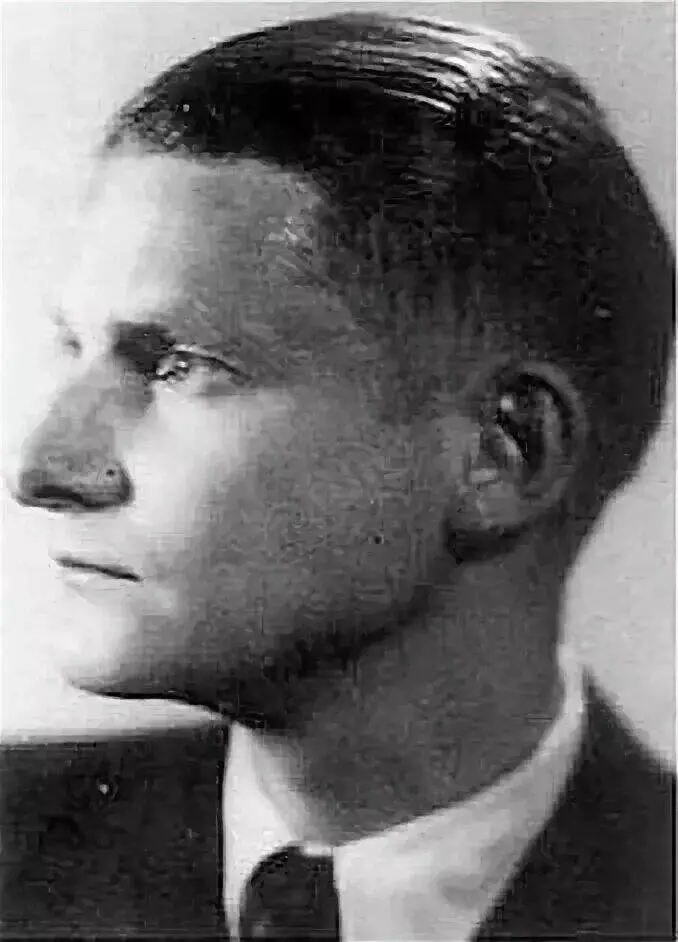
Voldemar Voigt
I would like to briefly dwell on Woldemar Voigt.
When I started looking for information about him, I immediately had the idea that after the Second World War he went to work in one of the American companies. Simply because there is a precedent in the form of Wernher von Braun and, more generally, of the entire Operation Paperclip, where, after the war, some ballistic missile and space program scientists from the country that started this war were sent, so to speak, to promotion, and not under the tribunal, where they belonged.
These facts somehow suggested that the designer of the first jet combat aircraft in history would be needed by the United States, which developed its jet aircraft as an offensive and defensive weapon for a future war with the USSR. And you already realized that Voigt also went to the USA?
Specifically, to Vought, where the Vought F7U Cutlass was developed under his leadership. At the same time, he also participated in the development of the first aircraft with variable sweep wing - Bell X-5. Knowing also that his removal was also part of Operation Paperclip, the fact that the designer who developed innovative but deadly machines was sent up the career ladder to the United States of America, and not to the dustbin of history - as a man performing orders that should not have been carried out becomes even more ominous.
I will not dissemble, I heard about the Milgram experiment, and it is an argument in such a controversy. But the problem is that Stanley Milgram's goal was not to justify or blame the Germans, albeit not without it, but to try to understand the actions of people who simply follow orders. And the data that the sociologist received led to the conclusion that a person cannot resist authority and, most importantly, society. But if society already stands up against authority, there will be no proper execution of orders.
Isn't this what happened at the end of the history of the "thousand-year Reich", to recall the same operation "Valkyrie". The example is important, because if Otto Ohlendorf, head of the Einsatzgruppen, who between June 1941 and June 1942 killed 90 people, mostly civilians, did not like individual executions, he should have done at least something against such orders, and not spoke Nuremberg trials that he was against them because it caused "an undesirable psychological reaction both in the victims and in those who were ordered to carry out the execution."
If you don't like it, then move on. Act like the authors of Operation Valkyrie, namely Ludwig Beck, Erwin von Witzleben, Walther von Bruchitsch, Erich Hoepner, Walther von Brockdorff-Ahlefeld, Wilhelm Franz Canaris, Hans Oster, Johannes Popitz, Hjalmar Schacht, Carl Goerdeler and Ulrich von Hassel . Change the balance of power, and don't make excuses later at the tribunal, they say, you had no choice. He had a choice.
But the fact that Waldemar Voigt was a scientist and, so to speak, simply followed orders, although I have already expressed my position on this matter, is quite interesting precisely in the context of scientists. Yes, there is less demand from them, and it is possible that my example with Ohlendorf is not appropriate, but we are talking here about what was created by these scientists and in the name of what ideals.
I may have questions about what the discoveries of Fritz Haber and Hans von Ohain were created for, but they don’t arise for the discoveries of other scientists, which it’s even pointless to list, there were so many of them. But science is another weapon that is most dangerous in any war. This does not mean that you need to abandon the scientific method, just keep in mind the phrase "war is the engine of progress." And at the same time remember what war is, how it looks, who pays for it and who receives it.
Okay, I digress.
In general, the history of the development of Messerschmitt Me 262 draws on a separate book, and if you write it the way I like, that is, with context and lyrical digressions, then all two. But I'm not a writer, this article is not a book, and my story is not about the Messerschmitt Me 262, so let's go over only what might be useful to us. Fortunately, there are not so many such "guns". Although, how to tell, in any case, we will no longer delay.
Let's start with the main thing in a jet aircraft, especially in the first combat one - from the engine.
Engine
Despite the long work of Hans von Ohain, its development was very long and difficult. One well-known obese member of the NSDAP, ace of the First World War, Vice Fuhrer, Reich Minister of Aviation of Germany, Hermann Goering, contributed to this.
Of course, in aviation, despite his position, he had a direct and decisive significance, but not always the most popular. In other words, other people were doing aviation for him. But this did not stop the second person in the Third Reich from having time to screw up a little in terms of aviation. Not much, but very significant. Specifically: it was his actions that led to the reduction of people working on a jet engine, which in turn will lead to a slowdown in the development of the Messerschmitt Me 262.
"Did he have any reason for this?" - of course, yes, they were. Everything without exception in this world has a reason, and it is foolish to ignore them. Goering in this matter could rely on the opinion of privileged officials who had their role in the current situation in Germany, who campaigned for the production of light and simple Messerschmitt Bf 109. The idea of simplifying where possible is an unwritten dogma in aviation, which, with rare exceptions is violated.
For example, when the aircraft to be created should be 2-3 heads higher than everything that was before, as an example of the F-22, C-5, PZL-230, Horten Ho 229, or when the aircraft to be created is ideologically inferior modern doctrines, therefore, for competitiveness, it is made very innovative on all fronts, for example, the MiG-35. In other cases, simplification is an effective and profitable way to create an aircraft.
By the way, the second epithet in relation to the word "simplification" was also the reason for Goering. According to one of the alternative definitions, fascism is “an open terrorist dictatorship of the most reactionary, most chauvinistic, most imperialist elements of finance capital” (according to Georgy Dmitrov), and, as in any capitalist system, the state here protects the interests of capital. True, under fascism capitalism itself becomes power, which could not but affect the interests of Goering or Hitler.
As a result, we can state that the very prominent industrialist Willy Messerschmitt, who, by the way, after the war, spent two years (!) in prison for collaborating with the Nazi regime, and then returned to the production of aircraft, such as the Spanish HA-200, the Egyptian HA -300, licensed, created for the needs of Germany, in this case Western, G.91 and F-104, and after that he also became one of the organizers of Messerschmitt-Bölkow-Blohm, part of the future EADS, which in turn will become Airbus.
Okay, I'll start over...
fast bomber
Goering's idea in this matter was to protect the interests of Messerschmitt, whose goal was to "strike while the iron is hot", that is, to produce the popular Messerschmitt Bf 109 and its modifications, such as the Messerschmitt Me 209, while there was demand for it, which might not be the case. albeit an innovative, but crude and chaotic project of the first combat jet aircraft.
By the way, about the confusion that was introduced by the Supreme Fuhrer of the Third Reich - Adolf Hitler. On April 18, 1941, the Messerschmitt Me 262 had already made its first flight, but with one piston engine, since a jet engine was still being developed. I think von Ohain can be given a discount as a pioneer in this industry ...
In any case, the first step out of probably 5-10 in the transition to a new milestone in the development of aviation was made - on July 18, 1942, the Messerschmitt Me 262 made its first flight, breaking away from the runway on jet propulsion. A short flight for an airplane, but a giant takeoff for the entire aircraft industry - this day is truly great for aviation.
He, of course, is overshadowed by the realization of the country that was able to send this long-term construction on the first flight, and in general, why he was sent on this very first flight, but this does not cancel the monstrosity of this event for science. But this was half the battle at best, because now it was necessary to understand what such an aircraft would become. The choice was short-lived and shortened by Adolf Hitler - Messerschmitt Me 262 should be an attack aircraft.
"Why?! For what?!" I anticipate your questions.
To begin with, and this is very important for our history, problems in production also caused a delay in production. The main one is unacceptable engine vibration. Although, it would seem, much more, the war is already almost lost. But the harsh truth of the life of the first jet engines left no other choice - how to calmly start correcting the problems that had arisen.
But the problem with Hitler was more difficult to solve. You see, while most of the leadership, including Adolf Galland, proposed making the Messerschmitt Me 262 an interceptor against the bombers of the USSR and the allies, who were already conducting raids on German territory, including Berlin, Hitler proposed creating another continuation of the popular that moment of the trend, called the German word - Schnellbomber (fast bomber). For its time, it was a real genius of tactics - an ideal weapon for blitzkrieg. The fastest planes in the world, in theory overtaking even interceptors and operating deep behind enemy lines.
Hitler envisioned the Messerschmitt Me 262 as a counterweight to the Allied landing in France, which was bound to happen sooner or later. For such a role, jet engines suited brilliantly. The Arado Ar 234 was one of the fastest aircraft of its day and was also a Schnellbomber. Before him, such a fate should have been prepared for the Messerschmitt Me 262. Now something very similar is called by a different word, and the roles of such aircraft have changed - Interdictor. Examples of Interdictors are Su-24, A-5 Vigilante, Panavia Tornado. As you can see, already obsolete aircraft, de Havilland Mosquito.
By the way, another aircraft that will be very useful to us in the foreseeable future, the de Havilland Mosquito, can be attributed to the Schnellbomber topic. It is important to us because it was another aircraft that was in service with Sweden, but as a night fighter, it is also an interesting class in aviation. And it will also be replaced by the Saab 32. A little later, we will voice all the planes that the hero of this article was supposed to replace.
Hitler and Galland, who often enter into controversy and holivars, failed to come to some kind of consensus. As a result, the Messerschmitt Me 262 became a multifunctional aircraft, nevertheless more often performing fighter flights. In April 1944, he was already being put into operation, but he could no longer influence the situation that had developed for the Third Reich, which was good. But nothing prevented the Messerschmitt Me 262 from becoming a very formidable opponent on the battlefield, a forerunner of future development and an impressive museum exhibit.
This is exactly what happened to him. But the process launched by this aircraft began to grow like a mycelium, capturing more and more countries, and being a training manual for the creation of aircraft in the future. All the problems and advantages had already been studied - it only remained to improve. This happened.
The process of creating alternatives to the German genius began - simpler, more economical, verified, elaborated. Su-9, Nakajima Kikka and Saab J 21R began to appear, as a very early test of the pen of catching up countries, then there were F-86, Yak-15, MiG-15, F-80, La-15, Dassault Ouragan, Saab 29. Surviving Junkers Jumo 004 engines, installed on Messerschmitt Me 262 and Horten Ho 229, also became the prototype and support for new engines, the same Soviet RD-10 was a complete copy of the above-mentioned engine.
But while the big countries struggled through new challenges, there was one country that had not suffered from the war and had ambitions to "catch up and overtake" the generally recognized leaders - it was Sweden. Thus began the history of the Saab 32.
Information